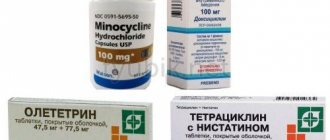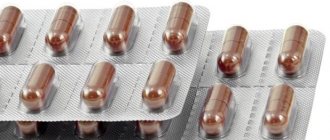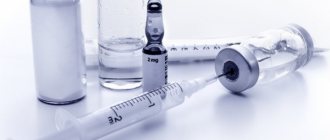The medical drug "Pharmatex" is a local non-hormonal contraceptive that protects, among other things, from infections transmitted exclusively through sexual contact. The product is recommended for use by women who have contraindications to the use of hormonal and intrauterine contraceptive drugs. Additionally, the drug “Pharmatex” can be used as an auxiliary protective measure with other options for protection. Reviews about its use are quite contradictory.
Release form and composition
Pharmatex is available in the following forms:
- vaginal tablets: white, round, with a hole in the center, odorless (12 pieces in polypropylene tubes, one tube in a cardboard package);
- vaginal capsules: soft, oval, light yellow, translucent; contents – white or white emulsion with a yellowish tint, sometimes the contents of the capsule may separate slightly (6 pieces in blisters, one or two blisters in a cardboard package);
- vaginal suppositories: cylindrical, cone-shaped at one end, white, with a characteristic odor (5 pieces in blisters, one or two blisters in a cardboard package);
- vaginal cream 1.2%: homogeneous, white, with a lavender scent (72 g in aluminum tubes, one tube in a cardboard package complete with a dispenser).
Composition for 1 vaginal tablet:
- active ingredient: benzalkonium chloride – 20 mg;
- auxiliary components: silicon dioxide hydrate, magnesium stearate, macrogol 6000, sodium bicarbonate, microcrystalline cellulose, lactose, anhydrous citric acid.
Composition for 1 vaginal capsule:
- active ingredient: benzalkonium chloride – 18.9 mg (in the form of a 50% aqueous solution of benzalkonium chloride);
- auxiliary components: colloidal silicon dioxide, macrogol-7-glyceryl cocoate, dimethicone 1000, hyprolose, macrogol 400;
- capsule shell: glycerol, gelatin.
Composition for 1 vaginal suppository:
- active ingredient: benzalkonium chloride – 18.9 mg (in the form of a 50% aqueous solution of benzalkonium chloride);
- auxiliary components: solid fat Witepsol S 51, hyprolose.
Composition per 1 g of vaginal cream:
- active ingredient: benzalkonium chloride – 12 mg (in the form of a 50% aqueous solution of benzalkonium chloride);
- auxiliary components: sodium hydrogen phosphate dodecahydrate, citric acid, lavender oil, Tefoz 63 (ethylene glycol and macrogol palmitostearate), purified water.
Pharmatex price
The cost of the drug Pharmatex depends on the form of release of the drug, the quality of purification of the active component, and excipients. The price can be set by the manufacturer. The medication is available for order in online pharmacies, where you can first read the reviews. Check out the approximate price of the medicine:
| Release form of the drug | Name of pharmacy, Moscow | Cost, rubles |
| Tablets, 8 pcs. | Avicenna | 253 |
| Suppositories, 12 pcs. | To your health | 320 |
| Cream, 50 g | Kalina Farm | 310 |
| Gel, 80 g | Pharmacy 24 | 437 |
| Tampons, 10 pcs. | Social Pharmacy | 511 |
Indications for use
Pharmatex is prescribed to women of reproductive age for local contraception in the following conditions:
- menopause period;
- postpartum period;
- breastfeeding period;
- irregular sexual intercourse;
- period after termination of pregnancy;
- omission or delay in taking an oral contraceptive used on a regular basis;
- the presence of contraindications to intrauterine contraception or the use of oral contraceptives;
- additional local contraception when using an intrauterine device or vaginal diaphragm.
Recommendations
If the need to use the drug is great, it is recommended to follow all the rules governing the use of the drug. If you feel the slightest deterioration, you should stop using the drug.
In this case, it is advisable to completely change the method of contraception or select a drug whose action will not be accompanied by such effects, and if there are unpleasant consequences, they could be easily eliminated.
If there is a strong burning sensation after using the drug, it is recommended to wash off its remnants from the skin. To do this, use water without using detergents. Usually after such actions all unpleasant consequences disappear. If itching, burning and pain persist, you should consult a doctor.
Directions for use and dosage
Vaginal tablets
Pharmatex in tablet form is inserted deep into the vagina. During the administration of the drug, the woman should be in a supine position. The tablet is administered no later than 10 minutes before sexual intercourse. The drug is effective for 3 hours. Before each repeated sexual intercourse, a new Pharmatex tablet must be administered. One tablet is designed for only one sexual act.
Vaginal capsules
The drug in capsule form is injected deep into the vagina. During the administration of Farmatex, the woman should be in a supine position. The capsule is administered 10 minutes or more before sexual intercourse. The drug is effective for 4 hours, but before each repeated sexual intercourse a new capsule must be administered, since one capsule is designed for only one sexual act.
Vaginal suppositories
Pharmatex in the form of suppositories is inserted deep into the vagina. At the time of drug administration, the woman should be in a supine position. Suppositories are administered no later than 5 minutes before sexual intercourse. The drug is effective for 4 hours, but before each repeated sexual intercourse a new suppository must be administered.
Vaginal cream
Before administering Farmatex in the form of a cream, it is necessary to attach the supplied dispenser to the tube instead of the cap, then gently squeeze out the contents until the dispenser is filled, trying to avoid the formation of air bubbles. After this, disconnect the dispenser and close the tube with the lid. Insert the cream deep into the vagina, slowly pressing the dispenser plunger (the woman should be lying on her back). The drug is effective for 10 hours, but before each sexual intercourse a new dose of the cream should be administered. One dose of the drug (5 g) is intended for only one sexual act.
If side effects occur
If you experience side effects, you can:
- change spermicide;
- change the method of contraception;
- find a drug that minimizes the occurrence of side effects (for example, if an allergic reaction occurs, then choose an antihistamine).
What can you do on your own if side effects occur? First, wash off the spermicide by rinsing the genitals with clean water. In most cases this is enough. Secondly, if you notice a deterioration in your condition, bleeding, or severe pain, call a doctor. Third, do not use this drug without consulting a specialist.
special instructions
For effective contraception, it is necessary to strictly follow the rules for using the drug Pharmatex:
- tablets (capsules, suppositories, cream) should be inserted into the vagina as deeply as possible, preferably while lying on your back;
- after administration of the drug, it is necessary to wait until the active substance is completely released (tablets and capsules dissolve within 10 minutes, suppositories - within 5 minutes);
- before each sexual intercourse, a new dose of Pharmatex should be administered;
- 2 hours before and 2 hours after sexual intercourse, it is prohibited to use soap for the toilet of the external genitalia, as it destroys the active substance of the drug;
- for external toilet of the genital organs, immediately after sexual intercourse, you must use clean water or a foaming product called Pharmatex containing benzalkonium chloride; vaginal irrigation can be carried out no earlier than 2 hours after sexual intercourse;
- after administering the drug into the vagina, it is forbidden to take baths, swim in the pool, sea or other bodies of water, as the subsequent contraceptive effect may be reduced;
- in case of exacerbation or occurrence of vaginal diseases, the use of Farmatex should be discontinued;
- when treating vaginal diseases or using other vaginal medications, you must wait until the end of the course of treatment and only then start (or resume) contraception with Pharmatex.
The drug does not affect the ability of patients to drive potentially dangerous machinery and vehicles.
pharmachologic effect
Shows bactericidal activity against staphylococci, streptococci, gram-negative bacteria (Escherichia coli and Pseudomonas aeruginosa, Proteus, Klebsiella, etc.), anaerobic bacteria, fungi and molds. Acts on strains of bacteria resistant to antibiotics and other chemotherapeutic drugs; inhibits plasmacoagulase and staphylococcal hyaluronidase. Prevents secondary infection of wounds by hospital strains of microorganisms. The spermicidal effect is due to the ability to damage sperm membranes (at the beginning of the flagella, then the head), which makes it impossible for the damaged sperm to fertilize. Activity begins at a concentration of 0.003% and reaches a maximum at a concentration of 0.005%, at which total destruction of sperm occurs in 20 seconds. Observation under a microscope shows an immediate effect on sperm, which is four times greater than the effect of nonoxynol-9. The high effectiveness of benzalkonium chloride is explained by its ability to line the vaginal mucosa and depends on compliance with the rules for using its dosage forms. The effect develops after 8-10 minutes (tablets), 5 minutes (vaginal suppositories), 3 minutes (cream) or immediately after insertion into the vagina (tampon). in vitro
active against Neisseria gonorrhoeae, Chlamydia spp., Trichomonas vaginalis, Human herpesvirus 2, Staphylococcus aureus.
Has no effect on Mycoplasma spp. and has little effect on Gardnerella vaginalis, Candida albicans, Haemophilus ducreyi and Treponema pallidum. In vivo
shows some activity in the prevention of some sexually transmitted diseases.
It has been shown that benzalkonium chloride is able to destroy lactobacilli that are part of the normal vaginal microbiota. At a concentration of 0.01% benzalkonium chloride inhibits the growth of L. crispatus
,
L. jensenii
,
L. gasseri
and
L. plantarum
.[2] Minimum inhibitory concentrations (MIC) of benzalkonium chloride for lactobacilli
L. crispatus
,
L. jensenii
and
L. gasseri
are less than 0.07 mg/ml [3], which is even less than the MIC of most antibiotics in relation to these lactobacilli. [4], [5], [6]
Birth control pills (hormonal contraceptives, oral contraceptives)
Hormonal birth control pills are also called oral contraceptives.
The mechanism of action of hormonal birth control pills is to suppress ovulation and/or thicken cervical mucus. Suppression of ovulation leads to the fact that the egg does not mature and does not leave the ovary into the fallopian tube. Thickening of cervical mucus makes the cervix impenetrable to sperm and the uterine lining unsuitable for the attachment of a fertilized egg.
Combination birth control pills contain both a hormonal drug to suppress ovulation and a hormonal drug to thicken cervical mucus. A typical combined contraceptive drug is Regulon.
Another combined contraceptive drug is Yarina. The active substance is drosperinone, the pharmacological profile of which is similar to that of natural progesterone.
Mini-pills are unidirectional birth control pills. They contain only a hormonal drug to thicken cervical mucus and change the properties of the uterine mucosa.
Emergency contraception is another group of hormonal birth control pills. These drugs suppress and delay ovulation, and also disrupt the process of fertilization and attachment of the egg to the uterus. Indications for the use of hormonal contraceptive pills for emergency contraception:
- unprotected sexual intercourse;
- improper use of mechanical contraceptives (condoms, vaginal diaphragms, caps, etc.);
- 3 or more missed doses of combined contraceptive pills;
- cases of sexual violence.
A typical drug for emergency contraception is Postinor.
In addition to tablets, hormonal contraceptives are produced in the form of hormonal intramuscular injections, Nova Ring intravaginal hormonal contraceptive rings, Evra contraceptive patch, Mirena hormonal intrauterine device, etc.
Subject to proper selection and regular long-term use, the effectiveness of hormonal contraceptives is very high - the Pearl index is below 3.
IMPORTANT! Even 1-2 missed doses of hormonal birth control pills increases the chance of getting pregnant several times!
Long-term use of hormonal contraceptives may be accompanied by nausea, vomiting, dizziness, headache, weight gain, and engorgement of the mammary glands.
Hormonal contraceptives are not recommended for use less than 1 month before planned surgical intervention, for hypertension, varicose veins, thrombophlebitis, migraine, acute infectious mononucleosis, severe hepatitis, diabetes mellitus, myocardial infarction, stroke, breast cancer, cervical cancer, cancer ovaries, severe atherosclerosis, during breastfeeding, etc.
Natural contraception
The most common methods of natural contraception are the calendar method, as well as the method of interrupted coitus.
The calendar method involves calculating the estimated date of ovulation (the maturation of the egg and the release of the egg from the ovary into the fallopian tube). During ovulation, your chances of getting pregnant are greatest. It is during this time that partners abstain from sexual intercourse or use a condom. The calendar method is low efficient - the Pearl index is above 30.
Coitus interruptus method - the man removes the penis from the vagina before ejaculation. The method, of course, is effective - the Pearl index is below 20.
Intrauterine contraceptives, or intrauterine devices
The principle of contraceptive action of intrauterine contraceptive devices is abortive action - spontaneous termination of pregnancy at 1 week.
The most common intrauterine contraceptive device is the intrauterine device.
The copper-containing intrauterine device has not only an abortifacient, but also a chemical effect; Moreover, the chemical contraceptive effect is much weaker than the abortifacient one.
The contraceptive effectiveness of the intrauterine device is comparable to hormonal birth control pills - the Pearl index is less than 3.









